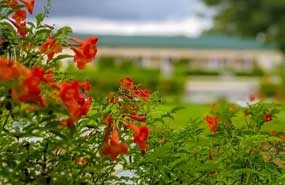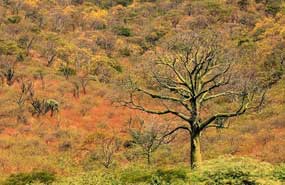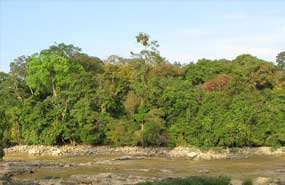
Sariska National Park is home to a rich variety of flora due to its location in the Aravalli Range. The vegetation in the park is mainly categorized into three types:
This type of forest is dominant in the park and covers more than 75% of the area. It is characterized by trees such as dhok, khair, tendu, and ber. The forest floor is covered with grasses, shrubs, and climbers.



This type of forest is found in the valley areas of the park and is characterized by trees such as champa, jamun, and arjun. The undergrowth is covered with grasses and shrubs.
The grasslands in Sariska National Park are located in the higher altitudes of the park and are characterized by tall grasses such as Themeda, Chrysopogon, and Cymbopogon. These grasslands also have scattered trees such as khejri, neem, and ber.
Alluvial savanna woodlands, inundated grasslands, tropical moist mixed deciduous forests, and tropical moist mixed deciduous forests are the dominant vegetation types in the Kaziranga forest.
Apart from these, the park is also home to several species of wildflowers such as daisies, marigold, and sunflowers, which bloom during the monsoon season.
The vegetation in the park supports a diverse range of wildlife, including tigers, leopards, and various species of deer, antelopes, and monkeys. The park's flora is a critical component of the ecosystem and plays a vital role in maintaining the delicate balance of the park's ecology.
Flora, or the plant life, is essential for a forest because it serves as the foundation of the ecosystem. The plants in a forest play a crucial role in maintaining the delicate balance of the forest ecology, and they provide a wide range of benefits, including:
Oxygen Production: Plants are the primary producers of oxygen through the process of photosynthesis. They take in carbon dioxide and release oxygen, which is vital for the survival of all living organisms.
Soil Conservation: The roots of plants help to hold the soil in place, preventing soil erosion and landslides.
Water Conservation: Plants play an essential role in maintaining the water cycle by absorbing water from the soil and releasing it into the atmosphere through transpiration.
Habitat Creation: The vegetation in a forest provides shelter and food for a diverse range of wildlife, from small insects to large mammals.
Climate Regulation: Trees absorb carbon dioxide, a greenhouse gas that contributes to global warming, and store carbon in their biomass. They also release water vapor into the atmosphere, which helps to regulate the temperature and humidity of the forest.
In summary, the flora in a forest is vital for maintaining the delicate balance of the forest ecosystem. It provides a wide range of benefits that support the survival of all living organisms in the forest, including humans.